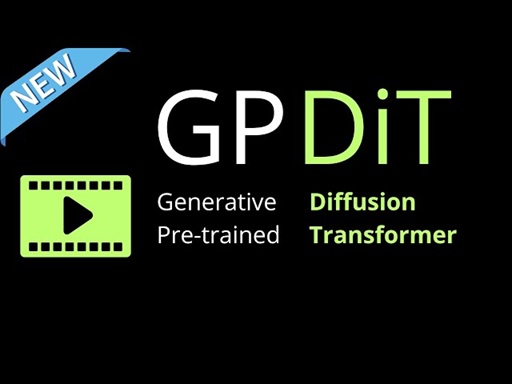
Introduction
This review examines recent significant AI research papers, focusing on GPDiT (Generative Pre-trained Auto-regressive Diffusion Transformer). The discussion centers on video generation using cutting-edge AI technology, specifically the new GPDiT architecture.
All About Generative Pre-trained Auto-regressive Diffusion Transformer (GPDiT)
What is GPDiT?
GPDiT (Generative Pre-trained Auto-regressive Diffusion Transformer) is a novel AI architecture for video generation developed by researchers from Peking University, Tsinghua University, SenseTime China, and the University of Science and Technology of China. Released in May 2025, GPDiT represents a significant advancement in video generation technology.
Key Innovations
GPDiT combines the strengths of two powerful AI approaches:
- Diffusion models – Known for high-quality sample generation
- Autoregressive models – Excellent at maintaining temporal consistency
The architecture operates in a continuous latent space rather than working directly with pixels, which allows it to better capture complex motion dynamics and semantic consistency across video frames.
Three Core Technical Components:
- Framewise autoregressive diffusion in continuous latent space
- Works with latent representations (likely from a variational autoencoder)
- Prediction is framed as a denoising task
- Preserves more intra-frame detail
- Allows the diffusion process to handle complex pixel distributions directly
- Lightweight causal attention mechanism
- Reduces computational complexity and memory costs
- Pre-computes key-value projections once
- Reuses them without further interaction for each new frame
- Parameter-free rotation-based time conditioning
- Replaces the traditional AdaLN-Zero module used in previous diffusion transformers
- Achieves similar effects of making the network’s behavior time-dependent
- Requires no new learnable parameters for time embedding
- Can be visualized as a rotation in 2D space where one axis represents clean data and the other represents noise
Capabilities
The most impressive capability of GPDiT is its video few-shot learning and in-context learning:
- The model can learn from minimal examples (few-shot learning)
- It can be conditioned via sequence concatenation
- It understands visual concepts, object appearances, motion patterns, and temporal relationships
Applications
GPDiT has demonstrated effectiveness in various video transformation tasks:
- Colorization (converting black and white videos to color)
- Depth estimation
- Style transfer in videos
- Edge detection
- Human skeleton detection/pose estimation
Why GPDiT Matters
- Integration of complementary approaches: Successfully combines diffusion models’ quality with autoregressive models’ temporal consistency
- Computational efficiency: Innovations in attention mechanisms and parameter-free time conditioning make complex video generation more efficient
- Few-shot learning: Enables video transformation with minimal examples, making it more practical for real-world applications
- Strong video understanding: Not just focused on generation but also demonstrates sophisticated understanding of video content
- Foundation for future work: As a pre-trained foundation model, GPDiT could potentially be fine-tuned for various downstream video tasks
Technical Explanation of Rotation-Based Time Conditioning
The rotation-based time conditioning is one of GPDiT’s most elegant innovations. It reinterprets the diffusion process as a rotation in a two-dimensional space:
- As diffusion progresses, data gradually moves from clean to noisy
- This transition can be mathematically represented as a point rotating in 2D space
- One axis represents clean data, the other represents pure noise
- The rotation angle indicates the mixing proportion at any given point in the diffusion process
This approach achieves similar functionality to more complex time conditioning mechanisms but without requiring additional learnable parameters.
Future Implications
GPDiT represents a significant step forward in AI’s ability to understand and generate video content. Its architecture could potentially influence future developments in:
- Extended video generation (longer sequences)
- Cross-modal video generation (text-to-video, audio-to-video)
- Video editing and manipulation tools
- Simulation environments for robotics and autonomous systems
- Enhanced video understanding for analysis applications
The combination of strong representation learning, efficient computation, and few-shot capabilities makes GPDiT a promising foundation for the next generation of video AI applications.
Video about GPDiT:
Related Section: Video of GPDiT
The most notable paper discussed is “Generative Pre-trained Auto-regressive Diffusion Transformer” by researchers from Peking University, Tsinghua University, SenseTime China, and the University of Science and Technology of China. The presenter emphasizes that this model enables video few-shot learning and video in-context learning capabilities.
GPDiT represents a significant advancement by combining two architectural approaches: diffusion transformers and autoregressive models. Traditional diffusion models use bidirectional attention over all frames but struggle with long-range temporal consistency. In contrast, language models excel at causality and sequence modeling but operate on tokens rather than pixels.
GPDiT functions as a foundational model that develops a broad understanding of visual concepts, object appearances, motion patterns, and temporal relationships in video sequences. It adapts transformer-based diffusion model concepts for video generation by making it autoregressive at the frame level, operating with mathematical operations in a continuous latent frame space.
Two key innovations in GPDiT include:
- A lightweight causal attention mechanism that reduces computational requirements
- A parameter-free rotation-based time conditioning method that improves upon previous approaches (AdaLN-Zero)
The core innovation is that “GPDiT autoreggressively predicts future latent frames using the diffusion loss, enabling natural modeling of motion dynamics and semantic consistency across all frames.”
The rotation-based time conditioning can be understood as interpreting “the forward diffusion process as a rotation in a two-dimensional space,” where “one axis is pure clean data and the other is pure noise. The angle of rotation tells you the mixing proportion at any given time.”
The three main technical components of GPDiT are:
- Framewise autoregressive diffusion in a continuous latent space
- Simplified causal attention that reduces memory costs
- Rotation-based time dependency injection that requires no new learnable parameters
The results demonstrate GPDiT’s impressive capabilities in video few-shot learning. The model can be conditioned via sequence concatenation, allowing it to learn from contextual demonstrations with minimal examples. The presenter shows examples where the model generates transformed video outputs based on input-output demonstrations, including colorization, depth estimation, human body skeleton detection, and more.
Conclusion
This comprehensive review of the latest AI research papers highlights GPDiT as a breakthrough in video generation technology. It effectively demonstrates how AI research is rapidly advancing, particularly in the domain of video understanding and generation.
Key Takeaway Points:
- GPDiT represents a novel fusion of diffusion models and autoregressive approaches, operating in continuous latent space to enable more powerful video generation capabilities.
- The rotation-based time conditioning mechanism offers a parameter-efficient alternative to previous methods, demonstrating how simple mathematical concepts can lead to significant improvements.
- Video few-shot learning and in-context learning capabilities allow the model to quickly adapt to specific video transformation tasks with minimal examples.
- The lightweight causal attention mechanism demonstrates how architectural optimizations can make complex models more computationally efficient.
- Beyond just generation, GPDiT’s design enhances video understanding capabilities, suggesting its potential applications extend beyond creative tasks to video analysis and interpretation.


